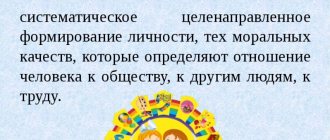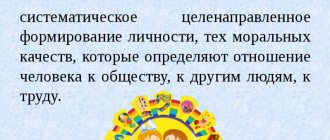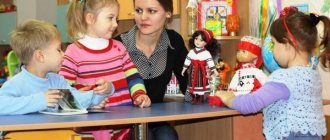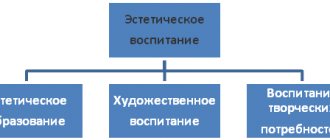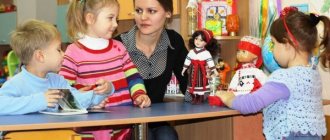Purpose of music education in preschool educational institutions
Definition 1
Musical education is a specially organized process of influence through the means of musical art, through which the aesthetic development of a child is realized, the foundations of his general culture are formed, and value guidelines are developed.
Musical education has a positive impact on personal development.
Music influences the formation of the creative component of the individual and contributes to the development of the creative foundations of his activity. and this, in turn, leads to the harmonious development of the child and the formation of all his qualities necessary for successful social life.
The main purpose of music education is the comprehensive harmonious development of the child’s personality. A number of subgoals of music education can be distinguished:
Are you an expert in this subject area? We invite you to become the author of the Directory Working Conditions
- Introducing a preschooler to the art of music. The child learns the basics of musical creativity, learns the aesthetic perception of music, and develops musical taste.
- Mastering the fundamentals of musical culture. Through it, the child learns the basics of general culture and forms his own views, attitude towards art, and develops his own line of cultural behavior.
- Development of musical abilities of a preschooler. Through musical education, a sense of rhythm, musical memory, auditory attention and perception are formed, which ultimately contributes to the formation of musical taste.
- Formation of the need for music. The need for musical creativity leads to the creative development of a preschooler.
- Implementation of different types of musical and artistic creativity of preschool children. In this way, the child can assert himself and realize himself in a creative direction, satisfy his creative needs.
Music classes in preschool educational institutions are aimed at developing in preschoolers a love of music, an interest in art, and the development of adequate musical taste and orientation skills in musical information.
Finished works on a similar topic
Course work Musical education of preschool children in preschool educational institutions 450 ₽ Abstract Musical education of preschool children in preschool educational institutions 280 ₽ Test work Musical education of preschool children in preschool educational institutions 230 ₽
Receive completed work or specialist advice on your educational project Find out the cost
Forms of organizing music education in preschool educational institutions
Musical education in preschool educational institutions is implemented in the following forms:
- Musical lessons. They are educational musical activities. During music lessons, the child’s intellectual, moral, aesthetic and cultural development is carried out. Musical classes include different types and areas of musical activity: singing, playing instruments, dancing, listening to music of different genres, getting acquainted with the work of great composers, mastering musical literacy.
- Independent musical activity of preschool children. It is associated with children demonstrating their creative abilities. They need to be encouraged to do this. Children apply their musical knowledge and focus it on their interests and needs.
- Music in everyday life. Music is becoming an important component of all types of preschool activities. It permeates all routine moments of the day. For example, music turns on when children are charging, it accompanies the gameplay. Getting ready for a walk can be accompanied by singing, etc. In addition, the preschool educational institution organizes holidays that are accompanied by musical performances.
- Musical education in the family. It is important to establish interactions with parents and form a unified direction of musical education. If music accompanies all the routine moments of a preschooler in a preschool educational institution, then at home it should also accompany the child. For example, a mother can find out what music the teacher plays during exercise and use it. At night you can sing a lullaby, etc. It is important that music be a constant component of a child’s life. An episodic nature will not give the desired educational effect.
Variable forms of musical activity of preschool children
Forms of organizing musical activities of preschool children in kindergarten: from traditions to innovations
V.A. Derkunskaya
Candidate of Pedagogical Sciences, Associate Professor of the Department of Preschool Pedagogy
RGPU named after. A.I. Herzen
The modern preschool child is mobile, active, dynamic and free. He manages to combine several types of activities at once, turning them into games and thus organizing his life. The preschooler’s inclination and interest in multi-activities makes us think about new forms of organizing the pedagogical process in kindergarten. The musical activity of children, which needs updating of forms, methods and techniques, is no exception.
The main forms of organizing the musical activities of preschoolers in kindergarten include: music classes; joint musical activity of adults (music director, teacher, preschool education specialist) and children in the everyday life of preschool educational institutions in a variety of forms; holidays and entertainment; independent musical activity of children.
In the work of a music director, the main form of organizing the direct educational musical activities of children is traditionally musical classes.
Musical classes come in several varieties. For example, individual, subgroup, frontal and combined, that is, the type of lesson is determined by the number of children participating in it.
Individual music lessons
are carried out separately with the child. This is typical for children of early and early preschool age. The duration of this lesson is 5-10 minutes, twice a week. For children of senior preschool age, individual lessons are organized with the aim of improving and developing musical abilities, abilities and skills of musical performance, in order to provide individual support to the pupil in musical education and development (for example, if this is a child who is often ill or has not attended kindergarten for a long time).
Subgroup music classes
are conducted with children two to three times a week for 10–20 minutes, depending on the age of the preschoolers.
Frontal exercises
are carried out with all children of the age group, their duration also depends on the age capabilities of the pupils.
Combined classes
organized with children of several age groups.
The next basis for classifying musical activities is its content. In this regard, a musical lesson can be typical or traditional, dominant, thematic, complex, integrative or integrative.
Typical (or traditional) music activity
includes all types of musical activity of children (perception, performance, creativity) and implies their sequential alternation. The structure of a music lesson may vary.
Dominant musical activity
is an activity with one predominant type of musical activity. Or an activity aimed at developing any one musical ability of children (for example, a sense of rhythm, a sense of mode, pitch hearing, etc.). In this case, it may include different types of musical activities, but under one condition - each of them is aimed at improving the child’s dominant ability.
Thematic music lesson
is determined by the presence of a specific theme, which is cross-cutting for all types of musical activities of children. Depending on the topic, classes are divided into thematic ones (for example, “Nature in music”, “Seasons in music”, “Music of my city”), where the main thing is to show the visual capabilities of music in conveying phenomena of the surrounding world. And musical-themed classes, in which the formulation of the theme is associated with the expressive means of music, with musical instruments, with the names and works of composers. Such classes are also called story music classes. They are united not only by one theme, but also by a single storyline (for example, “Fairy tale in music”, “Literary character in music”, “Winter stories and fables”). The integrity of the musical lesson in this case is achieved by the logic of the development of the chosen topic, which combines the content and types of musical activity of children.
Comprehensive music classes
are based on the interaction of various types of art - music, painting, literature, theater, architecture, etc. Their goal is to combine different types of artistic activities of children (musical, visual, theatrical, artistic and speech, productive), to enrich children’s ideas about the specifics of various types of art and the characteristics of expressive means; about the relationship between the arts. Preparation for complex classes is labor-intensive; it requires coordinated actions from the teacher and music director, senior teacher, and specialists. These classes are held approximately once a month frontally and, as a rule, starting with the middle group.
Integrated lesson
is distinguished by the presence of mutual influence and interpenetration (integration) of the content of different educational areas of the Program, different types of activities, different types of art, working primarily to reveal an idea or theme, a phenomenon, an image.
Based on the genesis of the development of musical activity of preschool children, we will determine the optimal forms of organizing the musical activity of preschool children.
Variable forms of musical activity of preschool children
At preschool educational institution
| Age | Leading activity | Modern forms and methods of musical activity |
| 1-3 years | Subject-based, subject-manipulative | — Game experimentation with sounds on an object basis; — Games-experiments with sounds and games-travels into the diverse world of sounds (non-musical and musical); — Object collecting (exhibition of rattles, children's musical instruments, favorite musical toys, etc.); — Musical and gaming techniques (onomatopoeia); — Musical and musical-literary riddles; — Musical finger and musical logarithmic games; — Musical and motor games-improvisation; — Musical fairy tales (listening and performing). |
| 3-5 years | Game (role-playing game) | — Musical role-playing games (song-game); — Musical fantasy games; — Game problem situations based on music; — Increasingly complex experimental games and travel games; — Musical and didactic games; — Game-sketches based on musical works; — Plot problem situations or situations with role interaction; — Concerts-mysteries; — Conversations, including conversations on children’s issues about music. |
| 5-7 years | Complex integrative activities, transition to educational activities | — Problematic and situational tasks, their wide variability, multi-problem nature. — Musical and didactic game; — Computer music games; — Research (experimental) activities; — Project activities; — Theatrical activities; — Round dance game; — Musical improvisation games; — Music competitions, festivals, concerts; — Musical excursions and walks, music museum; — Integrative activity (artistic activity); — Club of musical interests; — Collecting (including musical impressions); — Independent musical activity of children. |
A holiday in kindergarten is one of the key emotionally rich events in the common life of adults and children. It has always been considered as the result of the educational work of the institution, as a vivid presentation of the personal achievements of children, a kind of demonstration performance for parents and experts. It is distinguished from other forms by its solemnity and duration; in some cases, the holiday can last up to one and a half to two hours.
At its core, the holiday is one of the integrative forms of organizing children's artistic activities, which introduces children to the phenomena of social life through various types of art. A high degree of emotional impact on the child helps to effectively solve diverse educational problems in a holiday setting. Typical objectives of the holiday are: introducing preschoolers to national and world traditions and culture; nurturing a sense of patriotism and love for the Fatherland; fostering a respectful attitude towards history, the achievements of our country, social role, profession, and a specific person.
Modern holiday themes are diverse; today in kindergartens they celebrate both the traditional holidays of New Year, Defender of the Fatherland Day, Eighth of March, Victory Day, etc., and world holidays, for example, Mother's Day, Father's Day, Music Day. Maslenitsa and the graduation party have become mandatory in every kindergarten. The holiday can look like a concert, a competition (for example, KVN or like a popular TV show), dramatization, staging, sports and competitions, a complex or integrative activity.
A holiday as an integrative form of organizing children's artistic activities includes: artistic expression; songs (3-4 - in younger groups, 4-6 - in older groups); dancing; round dances; games, attraction games, playing children's musical instruments; skits, dramatizations, dramatizations.
The holiday has its own structure: a solemn introductory part, which includes formation, rebuilding, roll call, 2-3 songs; the main part, in which the storyline of the holiday is revealed, various performances by children and characters take place; the final part, which summarizes the idea of the holiday and may include quatrains and a final song dedicated to the main theme.
The main problem when organizing a holiday is to maintain a balance between the institution’s demonstration of the quality and effectiveness of educational work and the child’s presentation of personal achievements.
Changing the forms of joint musical activity entails a change in the nature of the pedagogical interaction between the teacher, music director and students.
In the works of the famous psychologist S.G. Jacobson highlighted positions that characterize the interaction between teacher and child during the educational process:
— “teacher-student” position;
— position of multi-competent partnership;
— position of equal-competent partnership;
— position of educational-game partnership.
The “teacher-student” position is ineffective from the point of view of the psychology of a preschooler. A teacher must teach a student regardless of the latter’s desires and preferences. A preschooler, due to his age, cannot force himself to complete a task that is completely uninteresting to him. Lack of interest, as a fundamental component in the education of a preschool child, dooms education itself to a lack of results or reduces it to the child’s reproductive acquisition of knowledge, skills and abilities.
The position of a multi-competent partnership means that the teacher acts in the position of someone who knows and can do something. His task is not to teach, but to interest children and share his experience with them. The child is no longer in a rigid position in relation to new knowledge; he independently regulates his behavior - whether he takes part or not in the interaction. In this case, we observe a voluntary partnership of educational participants. It should be noted that the teacher, in order to increase the cognitive, educational, and developmental motivation of children, will rely on the preferences of preschoolers, thereby creating conditions for the effective acquisition of knowledge and skills and their further application in everyday life. Another interesting approach to organizing interaction within this position is when the child himself acts as a competent participant, and from the position of an insufficiently competent participant - an adult, teacher, or music director. This inverted position allows the child to demonstrate the experience he has accumulated, transfer existing knowledge to a new situation - teach the teacher to do and know something. The child compares the motive and the goal, chooses the means of carrying out the activity, and evaluates the result obtained. The effectiveness of such a partnership is determined by how much the adult has learned to do something and whether the child is satisfied with his “educational work.”
The position of equal partnership is aimed at obtaining a common result. This position is presented in most detail in the works of N.A. Korotkova.
Considering the child as a subject of activity in different spheres of life, N.A. Korotkova and P.G. Nezhnov believe that the so-called life spheres stimulate the formation of the most important mental developments of age and ensure the emotional well-being of the child, his self-realization in various types of “cultural practices” (these are activities coming from an adult). The implementation of this principle is possible, according to the authors, when organizing a preschool program according to an optimal model, including the following blocks:
1. Joint partnership between an adult and children.
2. Free independent activity of the children themselves.
To implement the highlighted characteristics, according to N.A. Korotkova, it is necessary to reconsider the division into play and learning activities that is well-established in modern preschool pedagogy. ON THE. Korotkova notes that such a division leads to a violation of the integrity of the educational process and proposes a structure: play and related activities. Related activities include productive, cognitive-research and communicative activities or “cultural practice”.
This construction of the educational process entails a change in the positions of the teacher and the child in the process of interaction. The name of the activity coming from the teacher - “practice”, implies joint practice in an activity where the equality of its participants is established. During classes, the teacher and students take partner positions, which imply mutual respect and openness to each other. Consequently, the child will feel free, on an equal footing (as with peers in a game). Freedom promotes the development of activity and independence, the ability to make decisions based on existing knowledge, skills, and experience. The preschooler is not afraid that his actions will be regarded as incorrect. A positive attitude leads to emotional comfort during and after classes.
The partner position involves the selection of variable content and methods of completing tasks. Children can easily divide into “interest groups” when completing them. The partnership form of organizing a lesson involves an “open end”, i.e. Each child has the right to move at his own pace and complete the process when he sees fit. Children learn to plan and track, at the initial stages with the help of an adult, the results of their activities. In the position of equal partnership, a child, finding himself in a problematic pedagogical situation, is free to choose means and methods of solution.
The position of educational and play partnership is widely used in the practice of modern kindergartens. Its peculiarity lies in the appearance of a game character in a difficult situation during the lesson. Children become helping partners in solving a problem. Respect and praise from the game character act as additional motivation for activity. In this position, as in the two previous ones, the child is active in solving the problem, he is emotionally involved in the activity, and, therefore, the necessary prerequisites have been created for the formation of the musical culture of the preschooler, his competence and the formation of the child as a subject of musical activity.
Organizing independent musical activity for preschool children is perhaps the most difficult task for a teacher. Such activities arise on the initiative of children, without the participation of an adult or with little help from the teacher. The basis of a child’s independent musical activity is an incentive – a great desire to share his musical impressions and experiences, the desire to prolong communication with music. And an equally important motive is to express oneself, to realize oneself through interaction with musical art.
The conditions for the emergence of independent musical activity in preschoolers are:
— experience of communicating with music (accumulated emotions, feelings, images);
- experience in musical activity (a combination of skills in music perception and performance skills (singing, musical-rhythmic skills, skills in playing children's musical instruments).
The conditions for a teacher to organize independent musical activities for preschoolers include:
— taking into account children’s musical interests and preferences, the child’s subjective qualities in musical activity;
- non-dominant nature of interaction with children, indirect participation of adults in children’s activities;
- a well-thought-out object-based play environment (the availability of musical toys and instruments, manuals, didactic games, attributes of musical activity) and its accessibility to children.
A fundamentally important point in the organization and development of children’s independent musical activity is the mastery by preschoolers of ways to transfer musical impressions, ideas, skills and abilities to new conditions. The solution to this problem occurs in certain forms of joint activity between adults and children.
Their specificity unfolds in a certain logic aimed at developing children’s independence: from actions based on the teacher’s demonstration or model, to proactive unintentional actions and further to improvisation and creativity. It is important to help the child understand the tasks assigned to him, understand the essence of the proposed tasks, support the desire to complete them, and select the necessary methods and solutions. This is the formation of independent activity of preschoolers, their development of methods of independent action.
| Type of musical activity | Tasks of developing independence | Forms, methods and techniques for organizing independent musical activities of children |
| Hearing |
| Game problem and search situations related to music; Conversations and stories about music; Music quiz; Leisure “Guess the melody”; Musical games “What music is like”, “Listen and draw music”, “Listen and play music”, “Listen to music and read”, “Listen and feel music”; Musical metaphors; Fantasy games or imaginary situations; Musical empathy games; Musical color modeling, “Musical drawing”; Drama games, mood games, image games, reflection games. |
| Performing (singing, musical and rhythmic activities, playing children's musical instruments) | Singing | Project activity “My favorite song” or “Songs of our group”; Musical competition “Voice”, “Musical minute of glory”, “Battle of choirs (duets)”; We compose music (song) for a cartoon, fairy tale, story; Intonation improvisation games and onomatopoeia games; Vocal and speech games; Musical improvisation games (compose a melody for the text, a song motif, compose music for your poem, etc.). |
| ||
| Musical and rhythmic activity | Dance improvisation games; Project activity “Everyone is dancing!”; Musical competition "Big Dance"; Musical walks; Musical games of likeness; Museum of Dance; Interest club. | |
| ||
| Playing children's musical instruments | Problem and search situations using children's musical instruments; Musical and didactic games; Game “Create an artistic image”; Games “Voicing a poem”, “Voicing a character”; Game “Literary plot and characters in the language of musical instruments”; Musical fairy tale (dramatization game); Improvisation games; Co-creation games. | |
| Development of basic music-making skills. Development of skills to select familiar melodies and compose simple rhythmic compositions. |
The nature of the activity – whether it is reproducing or creative – depends on the variety of forms of organization of children’s independent musical activity.
The forms proposed in the table are aimed at developing independent musical creative activity of preschoolers.
The development of children's independence is facilitated by entertainment and holidays, which evoke a strong emotional response and keen interest in children. It is advisable to include in the script tasks for preschoolers of an improvisational nature, encouraging them to take initiative and independent creative actions. A modern approach to organizing musical leisure or a holiday involves the inclusion of children on an equal basis with adults. They act as co-directors of the event, offer a variety of ideas, images, ways to implement them, distribute roles, select attributes, decorations, determine the location of the action, and ways for invited guests to participate in the holiday. With such an organization, the development of independence in children will increase naturally, as the habit of acting proactively, “being inside” the activity and being active is cultivated.
The development of independent musical activity is facilitated by the integration of the arts, since children have a wide opportunity to holistically imagine or create an artistic image. By receiving a variety of means of expressiveness of artistic images, the child gets the opportunity to see and experience reality more deeply and comprehensively, to immerse himself in the world of beauty - music, literature, theater, architecture, painting, dance. Integration gives the child the opportunity to choose the means of expressiveness of an artistic image, its embodiment on paper or in movement, in words or in musical sounds, and the choice is always a consequence of initiative and independence.
Among the conditions that develop the independence of musical activity of preschoolers, an object-based play environment was noted.
Let us dwell on the principles of its construction that support the musical interests, initiatives and abilities of children:
— taking into account the level of musical development of preschool children;
— taking into account musical interests, subculture and individual characteristics of children;
- figurative, musical nature of the content of the environment;
— syncretic and multifunctional nature of equipment, objects and materials;
— accessibility of equipment, items and materials to children.
A correctly created object-based play environment in a group allows the child to independently actualize his musical experience. And manifestations of independence in musical activity can be considered as an indicator of the personal attitude of a preschooler to music and the process of musical education in kindergarten.
The structure of a music lesson in a preschool educational institution
Music classes at preschool educational institutions consist of the following components:
- Introductory part. It is aimed at preparing preschoolers to become familiar with music. In the introductory part of the lesson, you can include physical education components: performing movements to music, performing dance steps. This stimulates the preschooler’s musical activity and makes music lessons more productive.
- Listening to music. This part is focused on developing preschoolers’ skills in aesthetic perception of musical creativity and the formation of musical perception.
- Singing and song creativity. Children sing songs of different genres and also learn to compose songs on their own. Independent composing of a song motivates a preschooler’s interest in the art of music and helps to reveal his creative potential.
- Learning to play musical instruments. Typically, instruments are selected that are accessible to a specific age group. The teacher demonstrates their sound and shows the basics of playing melodies. Then the children themselves try to master playing this or that instrument.
- Dance activity. Dancing promotes the development of musical rhythm and creates a positive attitude towards music, because dancing is fun.
- Game activity. It is not a component of every music lesson, but may be included periodically. The game helps to absorb musical information more productively.
Methods and techniques for musical education of preschool children
The following methods are used to form a musical culture:
- Contrastive comparison - a system of tasks has been developed that are based on listening to different interpretations of the same work. By contrast, students learn to understand the meaning of a work and break it down into its component parts.
- Assimilation to the character of the sound consists of an emotional adjustment to the sound and in expressing one’s attitude towards the works being listened to. Similarity can manifest itself in a variety of forms: singing along, dancing, choosing clothes, etc.
- Tactile assimilation - the teacher touches the child’s hand to set him up to listen to the musical playback for maximum insight into its essence.
- Mimic assimilation - when listening to works, children look at the teacher and expect his assessment of what is happening. To develop musical taste, you will need to show emotions that correspond to the nature of the work. For example, it is appropriate to smile, make a serious face, and show passion. Children in preschool age are subconsciously drawn to adults, copying their behavior and emotions.
- Intonation assimilation - when listening to compositions, you need to express your attitude in words and replicas. In preschool age, it is difficult for children to grasp the meaning of words, phrases or sentences if they explain the essence of the composition in difficult to understand language. Therefore, it is better to express your attitude to music in simple words that are understandable for children, but saturated with bright emotional coloring. They act directly on the subconscious, bypassing the stage of mental comprehension of what is heard.
- Color comparison - when listening to a composition, you need to show the students cards with colors and associate a certain color with the general mood of the work. For example, when listening to a calm composition, the color blue is shown; for an active and sound-rich song, you need to show the color red. When listening to subsequent melodies, you should ask the children what color this or that song is associated with.
Methods of teaching reading to preschool children
Conditions for the effective organization of music education in preschool educational institutions
In order for musical education to be productive, a number of conditions for its organization must be observed:
- Taking into account the age and individual characteristics of preschool children when planning a music lesson;
- Focus on the musical development of preschool children not only during music lessons, but in everyday life;
- The content of music classes should reflect the purpose of music education;
- The results of a preschooler’s musical development should be noticeable in the child’s daily activities - he transfers his knowledge and skills into his life activities;
- The teacher does not have an active educational influence on the musical development of the preschooler. The teacher identifies himself as an equal partner in joint musical activities, giving the child maximum independence in musical knowledge and development.
Get paid for your student work
Coursework, abstracts or other works

